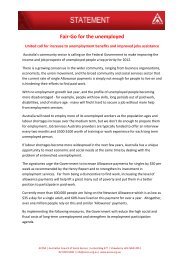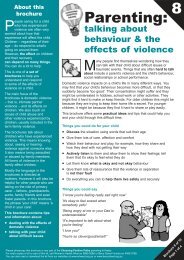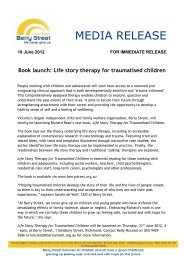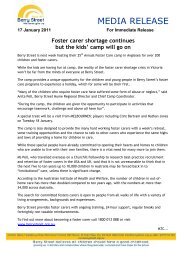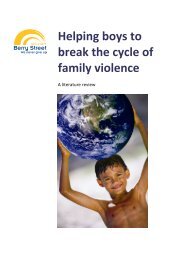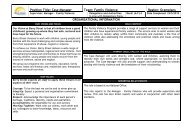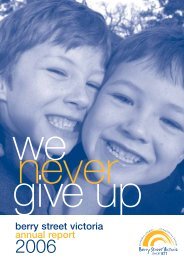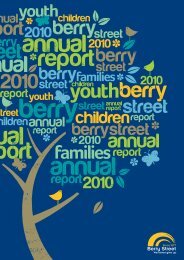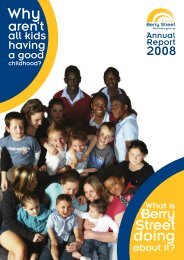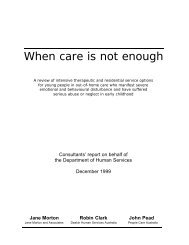Take Two - Third Evaluation Report More than Words ... - Berry Street
Take Two - Third Evaluation Report More than Words ... - Berry Street
Take Two - Third Evaluation Report More than Words ... - Berry Street
You also want an ePaper? Increase the reach of your titles
YUMPU automatically turns print PDFs into web optimized ePapers that Google loves.
differences between their HCA and that of the referrer.<br />
There were 51 (22%) situations where the <strong>Take</strong> <strong>Two</strong><br />
clinician’s HCA differed from the referrers in terms of<br />
the child’s past experience of abuse or neglect. Some<br />
(n=6; 3%) of the differences were due to the child<br />
suffering new experiences of abuse and neglect since<br />
the previous HCA and some were due to new information<br />
becoming available (n=7; 3%). However, according to<br />
the <strong>Take</strong> <strong>Two</strong> clinicians, the majority of differences were<br />
either due to <strong>Take</strong> <strong>Two</strong> undertaking a more detailed<br />
assessment (n=12; 5%) or a difference of opinion or<br />
interpretation of the information (n=26; 11%).<br />
This is not to say that the <strong>Take</strong> <strong>Two</strong> clinician’s opinion<br />
was more valid or accurate, but that any data collection<br />
process based on opinion is subject to variability.<br />
Strategies to increase validity included initial training<br />
throughout the state regarding the referral document<br />
and process, such as the need to review the client’s le<br />
and to not just focus on the most recent experiences<br />
of abuse and neglect. However, it is understood that as<br />
with any data collection process, issues of time, recency<br />
of training, focus on recent or most severe incidents<br />
and other factors can in uence accuracy. Since this<br />
exercise, adaptations have occurred within the HCA<br />
including help text available within the computerised<br />
version and further statewide training.<br />
Despite limitations to the accuracy of the HCA, it is still<br />
considered considerably more informative <strong>than</strong> other<br />
available data sources. For example, data collected via<br />
the DHS–CRIS system primarily report on abuse and<br />
neglect that have been substantiated at the beginning<br />
of each episode of child protection involvement, and<br />
not on experiences that were substantiated within<br />
an episode. The CRIS data regarding substantiated<br />
abuse are available to <strong>Take</strong> <strong>Two</strong> through the CYPP<br />
document and are considerably less detailed and less<br />
comprehensive about the children’s experiences.<br />
2.10.2 Measuring consequences of abuse and<br />
neglect, such as behavioural, emotional and<br />
developmental dif culties<br />
Similar to measuring the occurrences of abuse and<br />
neglect, measuring its consequences is multifaceted<br />
and complex. In fact it is probably more so, as it is<br />
a supposition in the rst place that the children’s<br />
emotional, developmental, behavioural and other<br />
dif culties are a consequence of these abusive<br />
experiences. The limitations regarding the HCA also<br />
apply to this question of consequences. In comparison<br />
between the referrers’ and <strong>Take</strong> <strong>Two</strong> clinicians’ HCAs<br />
undertaken in 2005, a similar level of difference was<br />
found regarding consequences. Of the 66 (28%) HCAs<br />
completed by <strong>Take</strong> <strong>Two</strong> clinicians that differed from<br />
the referrers’, 20 (9%) were due to either an increase<br />
or a decrease in dif culties since the time of referral.<br />
The majority (n=34; 15%) were due to a difference<br />
in assessment, which is to be expected given that a<br />
common request to <strong>Take</strong> <strong>Two</strong> was to undertake a more<br />
detailed assessment of the children’s dif culties. Eleven<br />
HCAs (5%) showed a difference of opinion, according to<br />
the <strong>Take</strong> <strong>Two</strong> clinicians.<br />
Measuring children’s emotional, social and behavioural<br />
dif culties as well as trauma symptoms is obviously a<br />
major aspect of <strong>Take</strong> <strong>Two</strong>’s assessment role including<br />
the use of standardised and other measures, such as<br />
the SDQ, TSCC, TSCYC and the Social Network Map.<br />
Each of these measures has speci c limitations, but<br />
12<br />
a general limitation is the reliance on questionnaire<br />
approaches to ascertain emotional dif culties. There is<br />
exciting research regarding the use of neurobiological<br />
measures to ascertain levels of physiological arousal<br />
and dysregulation, such as heart rate and cortisol<br />
levels (e.g. Dozier, Peloso, Lindhiem, Gordon, Manni,<br />
& Sepulveda et al., 2006; Fox & Card, 1999). However,<br />
the complexities of including these measures in a<br />
non-laboratory clinical program in addition to the<br />
increased resources and training required would need<br />
to be carefully weighed before deciding whether to<br />
incorporate them in the <strong>Take</strong> <strong>Two</strong> research strategy.<br />
A major strategy to minimise the limitations of the<br />
questionnaire approach is to have multiple measures so<br />
that the data can be triangulated.<br />
2.10.3 Describing and measuring <strong>Take</strong> <strong>Two</strong>’s<br />
work<br />
Therapeutic interventions have proven a dif cult area<br />
to describe and measure given the non-manualised<br />
nature of <strong>Take</strong> <strong>Two</strong>’s approach. <strong>Two</strong> main approaches<br />
have been used, namely a contemporaneous measure<br />
where clinicians enter regular activity logs and the<br />
retrospective measure of the clinicians’ survey that<br />
asks questions regarding the nature of the interventions<br />
used over the last year. The major limitation with the<br />
activity logs is associated with common problems<br />
associated with variable compliance with administrative<br />
tasks. The major limitation with the clinicians’ surveys is<br />
those associated with retrospective measures including<br />
discrepancies with memory and interpretation.<br />
2.10.4 Measuring outcomes and satisfaction with<br />
the service<br />
As noted earlier, a reliance on use of questionnaires has<br />
limitations, especially when being used for measuring<br />
outcomes. In addition, there are challenges to increase<br />
rates by clinicians to use the measures and to increase<br />
the likelihood of children, parents, carers and teachers<br />
in completing the measures. McNamara and Neve<br />
(2009) wrote of how to support clinicians to participate<br />
in the research aspects of their clinical work and cite<br />
<strong>Take</strong> <strong>Two</strong> as an example of how to achieve this goal.<br />
Nevertheless, this remains an ongoing challenge and<br />
commitment for <strong>Take</strong> <strong>Two</strong>.<br />
Stakeholder surveys have been another important<br />
means of gathering perspectives on whether positive<br />
changes have occurred and on the level of satisfaction<br />
with the program. All such surveys have limitations, such<br />
as needing to restrict the number of questions in order<br />
to be user friendly. This restricts the analysis to being<br />
relatively super cial as there is only one question per<br />
topic of interest. A design aw in the clinicians’ survey<br />
meant that the date of completion was not recorded<br />
and this led to some limitations in the analysis.<br />
2.11 Summary<br />
The design and methodology of evaluating the <strong>Take</strong><br />
<strong>Two</strong> program has developed alongside the program<br />
itself. This chapter has put the evaluation methodology<br />
within the context of the frameworks that informed its<br />
foundation, including the evaluation framework and the<br />
clinical outcomes framework. The chapter described the<br />
range of sources for data collection and the multi-level<br />
analyses of the work of <strong>Take</strong> <strong>Two</strong> with the individual<br />
children and the program as a whole.<br />
Frederico, Jackson, & Black (2010) “<strong>More</strong> <strong>than</strong> <strong>Words</strong>” – <strong>Take</strong> <strong>Two</strong> <strong>Third</strong> <strong>Evaluation</strong> <strong>Report</strong>, La Trobe University, Bundoora, Australia



